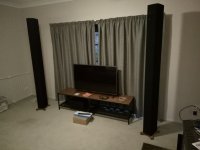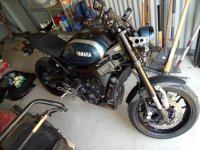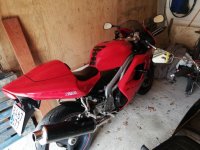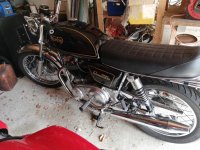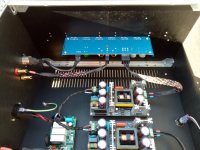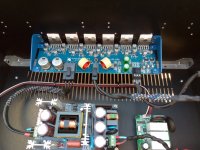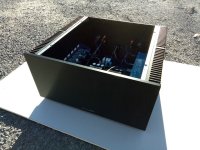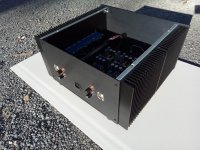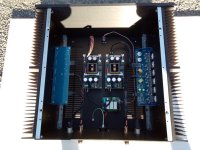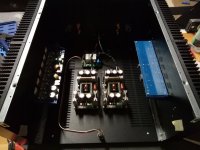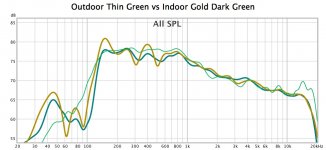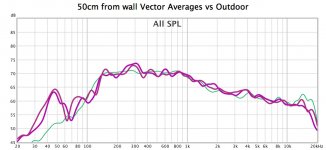Me too 😀Looking quite impressive! Massive amp! I like it 🙂.
All the parts have arrived and the power supplies test to the correct voltage which is good news. Chassis layout decisions have been made so I hope the amp will come together shortly.
Have been distracted by a new purchase, damn those hopeless non fireproof pockets 🙂
Attachments
Me too 😀
All the parts have arrived and the power supplies test to the correct voltage which is good news. Chassis layout decisions have been made so I hope the amp will come together shortly.
Have been distracted by a new purchase, damn those hopeless non fireproof pockets 🙂
I know exactly what you mean 😀
Attachments
Progress was slow on the week off took me all week to make the MOD686. Just tested it today and no magic smoke came out so that is a relief. I had a lot of trouble with the Keratherm insulators that I bought so I switched to ceramic. I haven't got round to trying the amp with any half decent speaker so I don't have any idea what it sounds like yet, hopefully nothing 😉
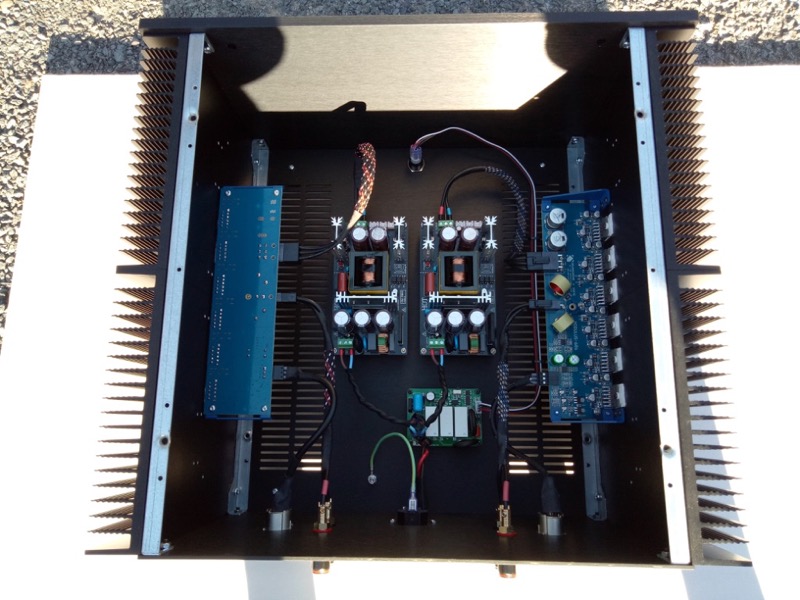
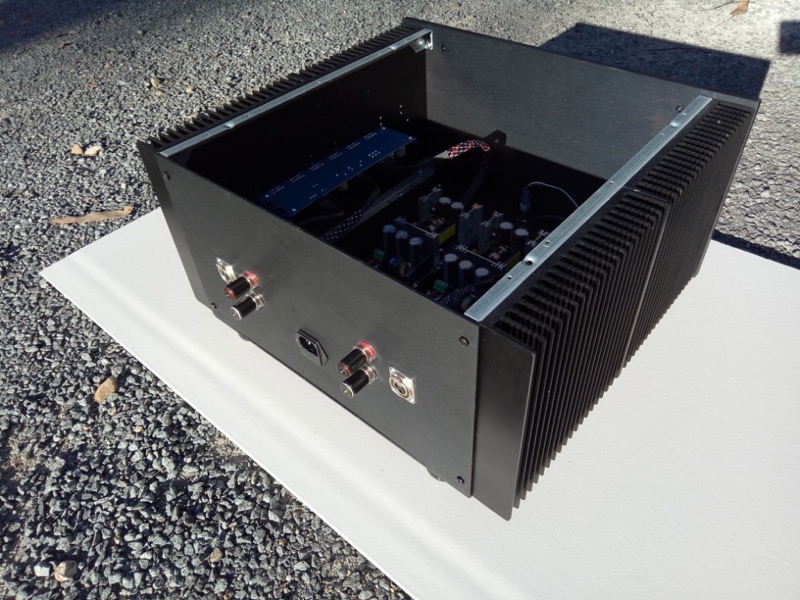

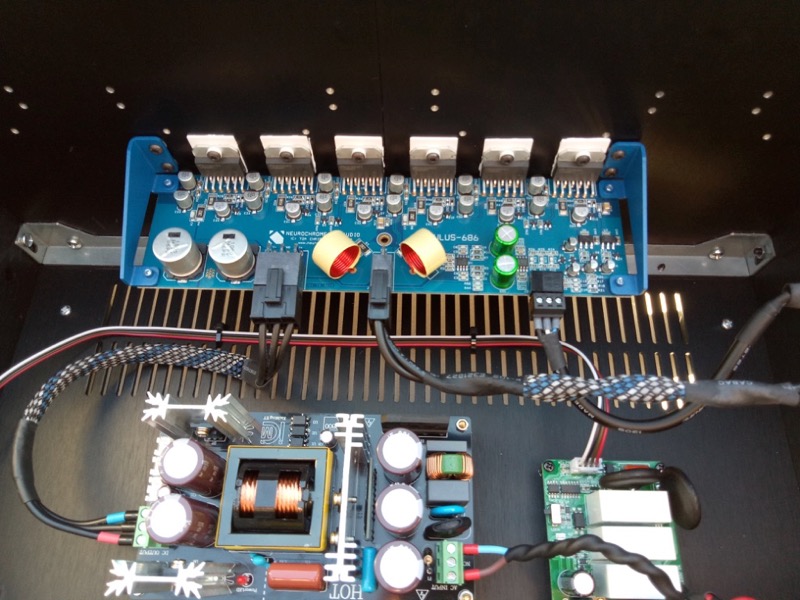
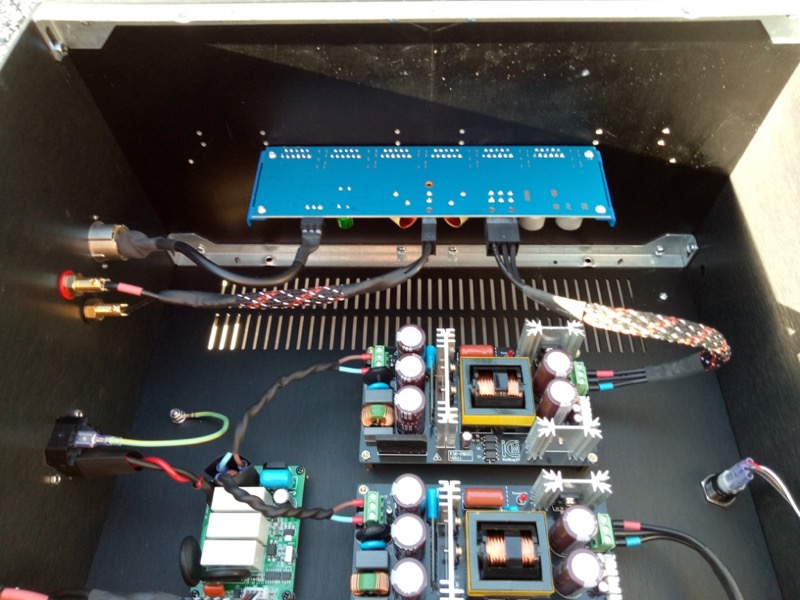
Attachments
Nice work Fluid.
Thanks! No matter how many times I make something I always underestimate how long it will take me.
Thanks! No matter how many times I make something I always underestimate how long it will take me.
Most project estimates....in terms of time and money...multiply it by a factor of two and it will most times be more accurate than the first

Guilty

I've heard that you should estimate and then multiply by a factor of π (pi) to get a realistic number...Most project estimates....in terms of time and money...multiply it by a factor of two and it will most times be more accurate than the first
Guilty
/Anton
Most project estimates....in terms of time and money...multiply it by a factor of two and it will most times be more accurate than the first
Guilty
I think you should multiply by PI... 🙂
I planned for two days and it took five, so I managed to beat pi by 1.28 days. So maybe I wasn't that slow after all 🙂
Ha Ha, have you applied that to your line array v2 😀
Not yet, its called denial

Nice work!!! Very clean working. Bet they sound great 🙂.
The longer I do things the closer I get to getting the correctly allocating resources. My formula is:
1. Estimate time and cost quickly.
2. Multiply cost by 3.
3. Multiply time by 2.
4. Add extra 20% to new calculated time.
5. Finish half the project.
6. Add additional cost of 15% and 25% extra time.
I think that is pretty close to PI!
The longer I do things the closer I get to getting the correctly allocating resources. My formula is:
1. Estimate time and cost quickly.
2. Multiply cost by 3.
3. Multiply time by 2.
4. Add extra 20% to new calculated time.
5. Finish half the project.
6. Add additional cost of 15% and 25% extra time.
I think that is pretty close to PI!
Progress on getting the arrays up and running has been slow but I have been able to get back to somewhere I am pretty happy with. The new room has been fairly problematic and caused me to go back basics.
I tried the speakers further away from the front wall than I had them before, that resulted in almost same response as outdoor with a few room induced nulls and peaks, too much boost needed and a virtual cliff in the response.
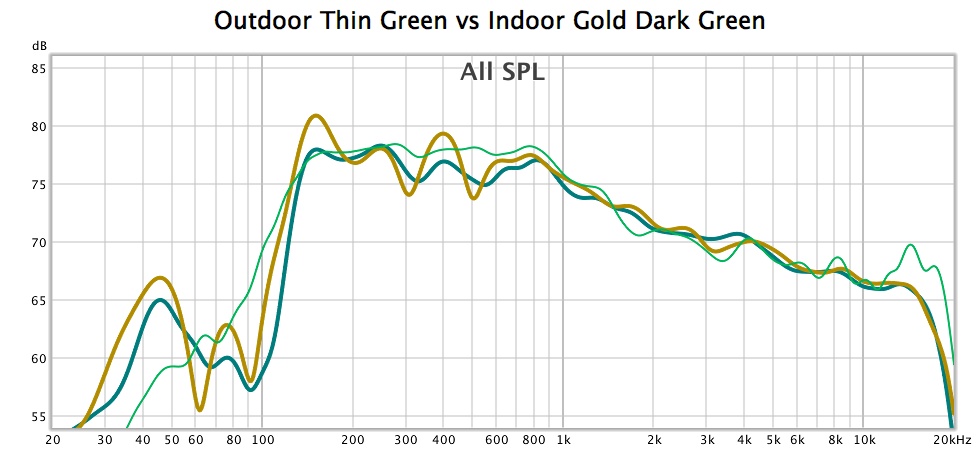
Back to 50cm from the front wall, not a huge change in raw response but enough to make the rest of the processing work better.
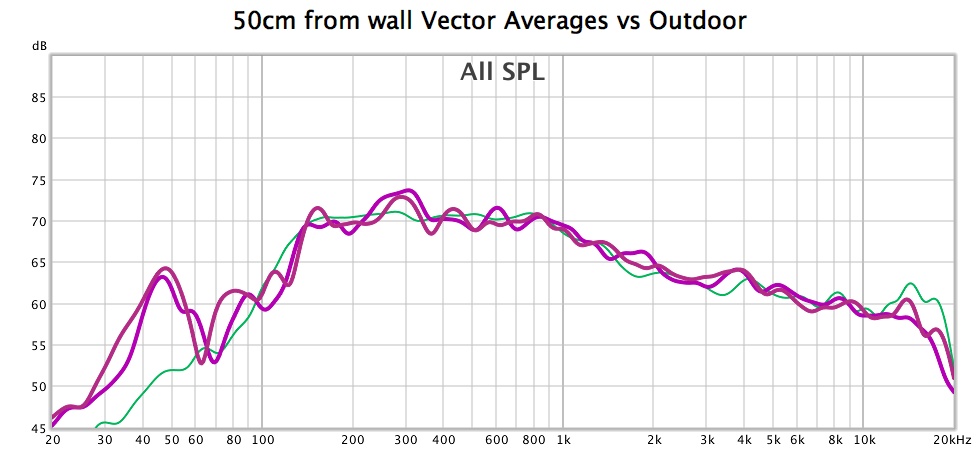
I tried wesayso's two stage make it as flat as you can before target EQ approach, too much was being asked of the correction and it sounded like it. When I get some treatment in I will revisit it to see what the difference is. As there is merit in the approach when less is being asked of the correction.
Single point measurements resulted in a very forced sound. A textbook example of a pretty graph sounding awful. Once I went back to a vector average of 4 positions things started to click back into place.
Previous targets did not work well and I have moved to something that wesayso has shown in his latest graphs, except I like it flatter beyond 1K with a few dips.
The mid side EQ is not having the same effect as before, but the better the raw the sound the better it works. Something else to be revisited when the treatment is in place.
I found an EQ setting from orartory1990 on reddit to correct my AKG K712 headphones to the 2018 Harman target curve, after quite a bit of listening this seems right to me with a few tweaks. Switching backwards and forwards just confused my ears and made it hard to determine a preference. I think you can definitely grow to "know" a sound and have that as your reference, as I have swung wildly in my preferences from before building the arrays to now. The EQ is quite different from the raw headphone sound but I think it will form a good base to refer back to on the journey forward.
Headphone measurements are hard to do correctly and previous attempts and EQ'ing them to other measurement were a bit of a fail, so if your headphones are on the list and you have a 10 band parametric EQ that is not constant Q then give it a try.
https://www.reddit.com/r/oratory1990/wiki/index
As to the MOD686 it is hard to make any real impressions due to the level of processing being used. I can't easily test it in a like for like comparison, but it has no issues playing all the tracks with near DC components. It is different to the First One as I briefly put that in to listen. As the base measurements used the mod686 I would have to take new measurements using the First One in exactly the same place to make a valid comparison. Maybe some day 🙂 I am going to take the extra capacitors out of the First One as I think they may be part of the issues I had with it tripping the DC protection.
Interesting snippet for nc535, while testing measurements out I was able to get a very close approximation of the outdoor measurement by using a multi point vector average on each channel and then vector averaging the two channels together. The less symmetry between channels the closer to outdoor you get.
I tried the speakers further away from the front wall than I had them before, that resulted in almost same response as outdoor with a few room induced nulls and peaks, too much boost needed and a virtual cliff in the response.
Back to 50cm from the front wall, not a huge change in raw response but enough to make the rest of the processing work better.
I tried wesayso's two stage make it as flat as you can before target EQ approach, too much was being asked of the correction and it sounded like it. When I get some treatment in I will revisit it to see what the difference is. As there is merit in the approach when less is being asked of the correction.
Single point measurements resulted in a very forced sound. A textbook example of a pretty graph sounding awful. Once I went back to a vector average of 4 positions things started to click back into place.
Previous targets did not work well and I have moved to something that wesayso has shown in his latest graphs, except I like it flatter beyond 1K with a few dips.
The mid side EQ is not having the same effect as before, but the better the raw the sound the better it works. Something else to be revisited when the treatment is in place.
I found an EQ setting from orartory1990 on reddit to correct my AKG K712 headphones to the 2018 Harman target curve, after quite a bit of listening this seems right to me with a few tweaks. Switching backwards and forwards just confused my ears and made it hard to determine a preference. I think you can definitely grow to "know" a sound and have that as your reference, as I have swung wildly in my preferences from before building the arrays to now. The EQ is quite different from the raw headphone sound but I think it will form a good base to refer back to on the journey forward.
Headphone measurements are hard to do correctly and previous attempts and EQ'ing them to other measurement were a bit of a fail, so if your headphones are on the list and you have a 10 band parametric EQ that is not constant Q then give it a try.
https://www.reddit.com/r/oratory1990/wiki/index
As to the MOD686 it is hard to make any real impressions due to the level of processing being used. I can't easily test it in a like for like comparison, but it has no issues playing all the tracks with near DC components. It is different to the First One as I briefly put that in to listen. As the base measurements used the mod686 I would have to take new measurements using the First One in exactly the same place to make a valid comparison. Maybe some day 🙂 I am going to take the extra capacitors out of the First One as I think they may be part of the issues I had with it tripping the DC protection.
Interesting snippet for nc535, while testing measurements out I was able to get a very close approximation of the outdoor measurement by using a multi point vector average on each channel and then vector averaging the two channels together. The less symmetry between channels the closer to outdoor you get.
Attachments
I can see your room is way more symmetrical than mine. The two follow each other more closely than , one in a corner, one on a free wall (with just a little bit of corner).
That makes it quite the task to get the bass part right I assume.
Indeed my two step DRC process will only work on relative clean measurements and preferably on an average of multiple measurements. Even I will load the correction by itself and single out big correction peaks to lower them. Multiple measurements averaged work well to smooth out dips like that. (that turn into the peaks for the corrective EQ)
That makes it quite the task to get the bass part right I assume.
Indeed my two step DRC process will only work on relative clean measurements and preferably on an average of multiple measurements. Even I will load the correction by itself and single out big correction peaks to lower them. Multiple measurements averaged work well to smooth out dips like that. (that turn into the peaks for the corrective EQ)
The room is less symmetrical than it seems as it is L shaped but there is a similar corner distance for each speaker. Both have a 140Hz null due to the distance from the front wall. I might be able to reduce that with absorbers behind the speakers the right has a null at 60 Hz as it can fire down the other side of the L it might be difficult to place absorbers to fix that one, but I might be able to reduce it. The energy is there but it comes quite late. For now I have the left one putting out more 60 Hz and that seems to work OK.
It might be different depending on placement of the subs.
I think it was more the full range phase correction on single measurements that put me off the flat correction template, averaged measurements are working much better for me, more treatment may swing the preference around again.
It might be different depending on placement of the subs.
I think it was more the full range phase correction on single measurements that put me off the flat correction template, averaged measurements are working much better for me, more treatment may swing the preference around again.
Looks like you are making nice progress setting up to new room. I always have to go back to basics too, whenever getting serious about matching to a room.
Re: flattening response, in particular out-of-band response before applying crossovers or attempting any other corrections...
Well....I nearly swear by this method...ever since learning it from Pos about 3 years ago.
It was always clear to flatten response in the pass band, wherever clear minimum phase variances are measured.
But it wasn't clear that natural roll-off is also minimum phase, and how beneficial out-of-band flattening is to implementing crossovers.
What I like, is when I apply whatever type/order crossover I want to use onto the 'pre-flattened' driver, and then measure the summed electrical transfer function, is becomes very clear whether the chosen xover frequency and order will work simply based on the boost required. (ignoring polars, excursion limits, etc)
6db boost is my threshold of OK. If more than 6db shows on the transfer, i know I have to move xover deeper into the passband, or increase xover order.
And what I really really like, is because of the 'pre-flattening' I can change the crossover freq, type, order, without doing anything else...no revisiting driver EQ etc. Easy peasy 😀
I know you probably have all this down...thought it might be helpful to others ...
Re: flattening response, in particular out-of-band response before applying crossovers or attempting any other corrections...
Well....I nearly swear by this method...ever since learning it from Pos about 3 years ago.
It was always clear to flatten response in the pass band, wherever clear minimum phase variances are measured.
But it wasn't clear that natural roll-off is also minimum phase, and how beneficial out-of-band flattening is to implementing crossovers.
What I like, is when I apply whatever type/order crossover I want to use onto the 'pre-flattened' driver, and then measure the summed electrical transfer function, is becomes very clear whether the chosen xover frequency and order will work simply based on the boost required. (ignoring polars, excursion limits, etc)
6db boost is my threshold of OK. If more than 6db shows on the transfer, i know I have to move xover deeper into the passband, or increase xover order.
And what I really really like, is because of the 'pre-flattening' I can change the crossover freq, type, order, without doing anything else...no revisiting driver EQ etc. Easy peasy 😀
I know you probably have all this down...thought it might be helpful to others ...
I'm going to have to subscribe to this thread if you guys are taking my name in vain. Almost missed the discussion; taking time away from speakers to do some landscaping.
140 Hz is too low to absorb with reasonable thickness. I would either put the arrays right on an absorber which is right on the wall or pull the arrays out far enough so null moves into sub territory.
140 Hz is too low to absorb with reasonable thickness. I would either put the arrays right on an absorber which is right on the wall or pull the arrays out far enough so null moves into sub territory.
- Home
- Loudspeakers
- Full Range
- Full Range TC9 Line Array CNC Cabinet

